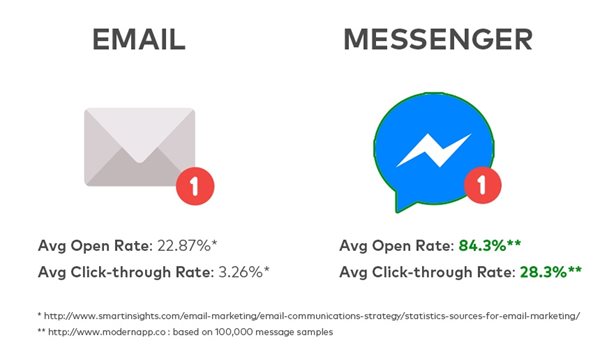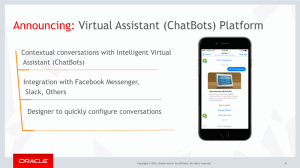Enterprises Set Themselves Up for Success via Chatbots
Gone are the days of building just another boring website to have a digital presence. We have  entered a new era where everything is connected to build next-generation digital experiences. The introduction of the iPhone in 2007 marked the mobile revolution which has entirely changed users’ expectations of the web and the digital experiences it generates. This situation started a ripple effect and with the rise of the mobile Internet, we shifted away from installed software on our desktops to mobile apps at our fingertips. The explosion of mobile apps reached a tipping point in 2008, and just like every other technology trend, it settled in over time. Now, it is passing the torch to support applications called bots. As Microsoft CEO Satya Nadella also agrees; “Bots are the new apps.”
entered a new era where everything is connected to build next-generation digital experiences. The introduction of the iPhone in 2007 marked the mobile revolution which has entirely changed users’ expectations of the web and the digital experiences it generates. This situation started a ripple effect and with the rise of the mobile Internet, we shifted away from installed software on our desktops to mobile apps at our fingertips. The explosion of mobile apps reached a tipping point in 2008, and just like every other technology trend, it settled in over time. Now, it is passing the torch to support applications called bots. As Microsoft CEO Satya Nadella also agrees; “Bots are the new apps.”
You may think how can messaging apps be a game-changer when it comes to driving B2B leads or you may be having a hard time envisioning a future where business people close a deal through a messaging app instead of an email. In fact, this is really happening and if you stick with me, these will all make perfect sense once you are done with this reading. I promise!
AI Chatbot Adoption across Enterprise by Numbers
First things first, let’s do a reality check on the adoption of chatbots across enterprise-level and large businesses. I hope you would like to see some stats on the matter as we are about to delve into some interesting findings that I have cherry-picked for you.
In terms of open rate and click-through rate, Facebook messenger, for instance, is much more effective. To be exact, it provides four times more open rate, and almost 10 times more click-throughs. Furthermore, given that it takes an average of five follow-ups to close a deal, an instant response via chatbot may go a long way in the business world.

As soon as Facebook allowed developers worldwide to create their own bots within Facebook Messenger in 2016, in the span of six months following the announcement, over 30,000 bots were created.
To see the trend of the worldwide interest in chatbots, here is a graph extracted from Google Analytics based on the Google search results of the “chatbot” term.
Oracle surveyed more than 800 senior marketing and sales professionals across Europe, the Middle East, and Africa (EMEA) to find out how the use of emerging technologies is set to surge by 2020. As a result, a whopping 80% expect to serve customers though chatbots by 2020, while 36% have already implemented them. Although the current adoption rate revealed doesn’t sound huge, it is reasonable to assume the wave is set to hit enterprises given most of its poll respondents have included it in their four-year tech adoption plans.
Based on data points disclosed by this survey, Business Insider estimated that when it is implemented wisely, chatbots may save businesses $23 billion in customer service representatives, and another $15 billion in sales representatives, meaning $38 billion in savings can be done in no time.
The same survey also revealed that 42% of participants believe automation technologies in the customer-facing areas, such as sales, marketing, and customer service, will most improve the customer experience.
Today six of the top 10 global apps are messaging apps, used by 1.4 billion people worldwide and growing by 12% annually. Facebook’s WhatsApp and Messenger are leading the pack.
Tech Providers' Take On Chatbots
Oracle made significant enhancements including chatbots and artificial intelligence with  enhanced mobile, video and messaging capabilities. With the new release, marketers are now able to customize responses during the conversations powered by an Oracle-connected chatbot on Facebook Messenger or Amazon Alexa. The technology is designed to detect the human’s intent and context, therefore, if the conversation between customer and chatbot becomes complicated, the tool will automatically hand it off to a live agent to avoid any potential frustration. According to Oracle, the capabilities also provide differentiated customer self-service experiences. On top of these, the new innovative chatbot capabilities are also expected to improve sales productivity as they automate common sales tasks such as account search, transaction creation, and updates.
enhanced mobile, video and messaging capabilities. With the new release, marketers are now able to customize responses during the conversations powered by an Oracle-connected chatbot on Facebook Messenger or Amazon Alexa. The technology is designed to detect the human’s intent and context, therefore, if the conversation between customer and chatbot becomes complicated, the tool will automatically hand it off to a live agent to avoid any potential frustration. According to Oracle, the capabilities also provide differentiated customer self-service experiences. On top of these, the new innovative chatbot capabilities are also expected to improve sales productivity as they automate common sales tasks such as account search, transaction creation, and updates.
“In a world where not everyone will download your mobile app but are using Facebook Messenger and Alexa-driven devices, chatbots are a way for you to play in these new conversational media,” Oracle group VP product management, Steve Krause, said. “The reason this matters is because of things like Messenger, Alexa, Google home – these are starting to happen and we’re only at the beginning of this trend. This is about enabling you to be there as a brand as interaction happens.”
According to Reuters, Chatbot maker [24]7 Inc expects its revenue to increase 30-35 percent to more than $400 million in its financial year ending March 2018. The company turned profitable by the end of 2003 and raised capital of about $22 million in the same year. PV Kannan, Co-founder and Chief Executive Officer of [24]7, commented on the concern of machines taking over humans’ jobs: “Not all domains are going to be automated. And the BPO business is not going away.”
Best Practices for Implementing Chatbots to Enterprise Sales Tunnel
So far, from an analytical standpoint, it has been convincing to include bots in our tech stack and content strategy. However, we still need to explore the real-world use cases so the reasoning behind the adoption would make perfect sense. When we look at the stages of a customer journey or a sales funnel, you will notice that there is a different level of maturity that needs to be met for each type of content and channel. Let’s say your prospect has just become aware of the fact that there is a problem. In this stage, which may be called an awareness stage, they are not looking for a solution yet. As they are experiencing and acknowledging the symptoms of a need or an issue, it would definitely be a good time to help them understand and identify their problem/situation. In other words, it is the time for educational content materials to come off the bench. If you wonder what the relevant type of content would be, informative, third party and vendor-neutral content such as eBooks, White Papers, Analyst Reports, Research Reports, Expert Content, Blogs, Case Studies, or a Newsletter could help you educate your prospects and start building a relationship with them.
After the awareness stage, then comes the consideration stage where prospects have clearly defined their problems or needs and it is time to carefully speak to solutions. This is where you can leverage a chatbot for instance. On either a specific landing page or your homepage, you may facilitate a chatbot and encourage your visitors to utilize it by providing them a value such as saving them time and energy on navigating to the website to find specific information or even going through the purchasing process. As a chatbot essentially learns to understand consumer habits, context, and intent to better predict and provide the content, information or engagement users are seeking, it is not a crazy idea to think that it also generates a lead. That way it frees up the time not only for your prospect but also for your sales team as it directs the prospect to the next step in the sales funnel.
With this purpose in mind, here are the standard best practices of incorporating a chatbot onto your website:
-
First, visitors are encouraged with a call to action that offers them assistance through Messenger.
-
The Chatbot can ask the user some relevant questions about their needs to start off the engagement.
-
In the case of research, the bot can then provide the content, information or engagement users are looking for. If the bot plays its cards right, thanks to the information provided, the prospect might present an interest in a further conversation with the organization. And viola! You have just gotten a lead.
-
In the case of mundane admin tasks, the bot can edit account or billing information, schedule meetings by syncing the sales team’s calendar or manage a financial transaction in no time. While your customer service is spending less time on a no-brainer task, your brand still maintains the feeling of connection and eliminates wait times, dropped calls, and lost tempers.
Like a chess grandmaster, today’s successful marketers think ahead of what their prospects/customers might be looking for so they can develop the right type of engagement in every step of a customer journey. To stay on top of the game requires various tactics and channels, and when a chatbot with the right strategy is thrown into that mix, it maximizes the impact of sales and marketing efforts.
Get Over the Chatbot Myth
Developers and data scientists have been working on computer systems that can recognize images and comprehend speech without the loss of accuracy and the nature of the conversation for decades. Despite its obvious benefits, as is typical in the adoption of new technologies, the pioneer organizations that got so hyped on the idea of implementing bots to engage with their audiences and automate their work processes experienced some failures as initially, bots didn’t work as planned. Because of these, initial, bad or limited interactions with automated systems became the coup de grâce for the adoption of bots. While the technology is still in its infancy, as artificial intelligence continues to evolve, most of the initial issues began to be ironed out.
Given that the combined number of Facebook Messenger and KIK users has already reached a billion, in my opinion, by 2020, the technology will reach its prime time. Brands, which don’t want to sit with laggards where they drag their feet and cling to antiquated ways, should be wasting no time looking into the best ways of incorporating chatbots with their other marketing tactics. As Kipp Bodnar, Chief Marketing Officer, Hubspot warns, “marketers’ best leverage exists when there’s a new audience that’s growing but not a lot of competition trying to reach that audience. When you invest in an emerging technology, you can be in front of a growing audience in a far less competitive landscape.”
What Businesses Can Achieve with Conversational Systems
Productivity: First off, whether it is about some account details or the level of the inventory, reaching accurate information in the most efficient manner when needed is getting more and more critical for businesses. Not only obtaining the information but also automation and delegation of day-to-day tasks directly contribute to productivity and efficiency of workforces. Therefore, having a trustworthy assistant hiding in your pocket or embedded in devices can increase productivity while reducing the time spent on searching information or connecting with people as well as the loss of accuracy.
Scalable customer service: Take a moment and imagine a scene at the airport where a flight has been canceled just before the departure time, and the airway company has only two personnel in the field to calm down 250 frustrated passengers while booking their next flight at once. In this scenario, if the company had been able to deliver the optimized chatbot experience for rapidly arranging stranded passengers’ next flights, their personnel could have dealt with passengers’ frustration through a better human interaction.
More relevant customer service: To me, the greatest benefit of these AI-driven conversations is that brands can pick up instantly what their customers need even before they know or tell through their strong understanding of context. Yes, the customer can be informed about approximately when their most recent order will arrive via an order confirmation email from the retailer, but the conversation on, say a messaging app, flows seamlessly between customer and support. Additionally, this on-going conversation is not only more natural and personal but also represents the opportunities for brands like cross-sell, social sharing, solicit input, and so on.
Omnichannel customer experience: Today, 91% of customers want to pick up where they left off from one channel to the next, disconnection between departments and channels is not something today’s consumer really wants to tolerate and especially millennials are not really known for their high tolerance and loyalty. In other words, customers should not feel any loss of context when they switch from one channel to another. To that point, it is critical that all your channels, whether voice, text, social or apps, should be conversational in nature with each other.
Globalization: San Francisco-based VoiceBase tapped into the Google Cloud Speech API to build a SaaS speech analytics platform that turns voice data into useful information that can help companies automate and gain insight into their operations. The company transcribes and processes millions of recordings every month for contact centers, conferencing service providers, video and education platforms, telecom providers and Fortune 500 companies. The service does not only provide transcripts but also offers tools to solve complex business problems — such as analyzing audio files and transcripts from call centers to predict the level of customer churn, and letting users search the timeline of a recording to find and play precise parts of a conference call, webinar, educational lecture, podcast or video interview.
Brand personality: Whether it is a chatbot, a virtual assistant, or a voice-activated assistant, the level of personalization that these technologies can deliver is not limited to only customers. Another important aspect of the business is brand identity, and cutting out human interaction can easily spoil it. However, the vendors are enhancing their platforms to deliver human-like responses, so brands can train their chatbots to have the same voice and tone, just like training their customer-facing employees, like for instance, launching an external API for developers, which Taco Bell has already publicized with its in-the-works ‘Tacobot‘, apparently capable of taking your order and doing so with ‘personality’. This is one of the areas of conversational systems for exploration by businesses.
Ending Notes
It is a fact that chatbots can save businesses millions of dollars if they are utilized with the right setup, however I believe, the benefits of this technology go well beyond labor-cost substitution as listed above. At the end of the day, it is important to know that the majority of the benefits of having bot-powered services implemented to your customer-facing process may not come from reducing labor costs, but from raising productivity through fewer errors, higher and faster output, and increased quality and safety.

Venus Tamturk
Venus is the Media Reporter for CMS-Connected, with one of her tasks to write thorough articles by creating the most up-to-date and engaging content using B2B digital marketing. She enjoys increasing brand equity and conversion through the strategic use of social media channels and integrated media marketing plans.